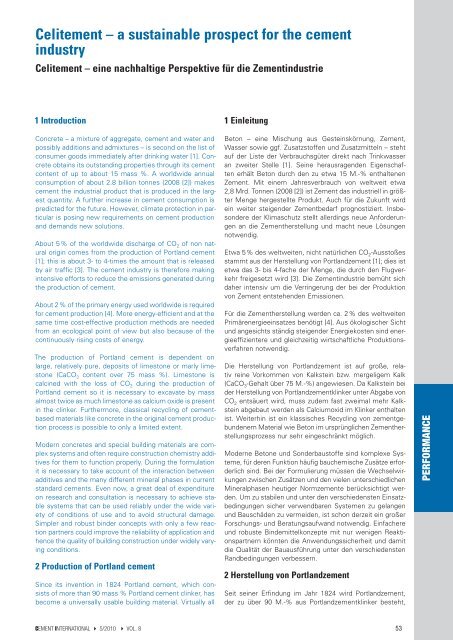Celitement – a sustainable prospect for the ... - Celitement GmbH
Celitement – a sustainable prospect for the ... - Celitement GmbH
Celitement – a sustainable prospect for the ... - Celitement GmbH
Erfolgreiche ePaper selbst erstellen
Machen Sie aus Ihren PDF Publikationen ein blätterbares Flipbook mit unserer einzigartigen Google optimierten e-Paper Software.
<strong>Celitement</strong> <strong>–</strong> a <strong>sustainable</strong> <strong>prospect</strong> <strong>for</strong> <strong>the</strong> cement<br />
industry<br />
<strong>Celitement</strong> <strong>–</strong> eine nachhaltige Perspektive für die Zementindustrie<br />
1 Introduction<br />
Concrete <strong>–</strong> a mixture of aggregate, cement and water and<br />
possibly additions and admixtures <strong>–</strong> is second on <strong>the</strong> list of<br />
consumer goods immediately after drinking water [1]. Concrete<br />
obtains its outstanding properties through its cement<br />
content of up to about 15 mass %. A worldwide annual<br />
consumption of about 2.8 billion tonnes (2008 [2]) makes<br />
cement <strong>the</strong> industrial product that is produced in <strong>the</strong> largest<br />
quantity. A fur<strong>the</strong>r increase in cement consumption is<br />
predicted <strong>for</strong> <strong>the</strong> future. However, climate protection in particular<br />
is posing new requirements on cement production<br />
and demands new solutions.<br />
About 5% of <strong>the</strong> worldwide discharge of CO 2 of non natural<br />
origin comes from <strong>the</strong> production of Portland cement<br />
[1]; this is about 3- to 4-times <strong>the</strong> amount that is released<br />
by air traffic [3]. The cement industry is <strong>the</strong>re<strong>for</strong>e making<br />
intensive ef<strong>for</strong>ts to reduce <strong>the</strong> emissions generated during<br />
<strong>the</strong> production of cement.<br />
About 2% of <strong>the</strong> primary energy used worldwide is required<br />
<strong>for</strong> cement production [4]. More energy-efficient and at <strong>the</strong><br />
same time cost-effective production methods are needed<br />
from an ecological point of view but also because of <strong>the</strong><br />
continuously rising costs of energy.<br />
The production of Portland cement is dependent on<br />
large, relatively pure, deposits of limestone or marly limestone<br />
(CaCO 3 content over 75 mass %). Limestone is<br />
calcined with <strong>the</strong> loss of CO 2 during <strong>the</strong> production of<br />
Portland cement so it is necessary to excavate by mass<br />
almost twice as much limestone as calcium oxide is present<br />
in <strong>the</strong> clinker. Fur<strong>the</strong>rmore, classical recycling of cementbased<br />
materials like concrete in <strong>the</strong> original cement production<br />
process is possible to only a limited extent.<br />
Modern concretes and special building materials are complex<br />
systems and often require construction chemistry additives<br />
<strong>for</strong> <strong>the</strong>m to function properly. During <strong>the</strong> <strong>for</strong>mulation<br />
it is necessary to take account of <strong>the</strong> interaction between<br />
additives and <strong>the</strong> many different mineral phases in current<br />
standard cements. Even now, a great deal of expenditure<br />
on research and consultation is necessary to achieve stable<br />
systems that can be used reliably under <strong>the</strong> wide variety<br />
of conditions of use and to avoid structural damage.<br />
Simpler and robust binder concepts with only a few reaction<br />
partners could improve <strong>the</strong> reliability of application and<br />
hence <strong>the</strong> quality of building construction under widely vary-<br />
ing conditions.<br />
2 Production of Portland cement<br />
Since its invention in 1824 Portland cement, which consists<br />
of more than 90 mass % Portland cement clinker, has<br />
become a universally usable building material. Virtually all<br />
1 Einleitung<br />
Beton <strong>–</strong> eine Mischung aus Gesteinskörnung, Zement,<br />
Wasser sowie ggf. Zusatzstoffen und Zusatzmitteln <strong>–</strong> steht<br />
auf der Liste der Verbrauchsgüter direkt nach Trinkwasser<br />
an zweiter Stelle [1]. Seine herausragenden Eigenschaften<br />
erhält Beton durch den zu etwa 15 M.-% enthaltenen<br />
Zement. Mit einem Jahresverbrauch von weltweit etwa<br />
2,8 Mrd. Tonnen (2008 [2]) ist Zement das industriell in größter<br />
Menge hergestellte Produkt. Auch für die Zukunft wird<br />
ein weiter steigender Zementbedarf prognostiziert. Insbesondere<br />
der Klimaschutz stellt allerdings neue An<strong>for</strong>derungen<br />
an die Zemen<strong>the</strong>rstellung und macht neue Lösungen<br />
notwendig.<br />
Etwa 5% des weltweiten, nicht natürlichen CO 2-Ausstoßes<br />
stammt aus der Herstellung von Portlandzement [1]; dies ist<br />
etwa das 3- bis 4-fache der Menge, die durch den Flugverkehr<br />
freigesetzt wird [3]. Die Zementindustrie bemüht sich<br />
daher intensiv um die Verringerung der bei der Produktion<br />
von Zement entstehenden Emissionen.<br />
Für die Zemen<strong>the</strong>rstellung werden ca. 2% des weltweiten<br />
Primärenergieeinsatzes benötigt [4]. Aus ökologischer Sicht<br />
und angesichts ständig steigender Energiekosten sind energieeffizientere<br />
und gleichzeitig wirtschaftliche Produktionsverfahren<br />
notwendig.<br />
Die Herstellung von Portlandzement ist auf große, relativ<br />
reine Vorkommen von Kalkstein bzw. mergeligem Kalk<br />
(CaCO 3-Gehalt über 75 M.-%) angewiesen. Da Kalkstein bei<br />
der Herstellung von Portlandzementklinker unter Abgabe von<br />
CO 2 entsäuert wird, muss zudem fast zweimal mehr Kalkstein<br />
abgebaut werden als Calciumoxid im Klinker enthalten<br />
ist. Weiterhin ist ein klassisches Recycling von zementgebundenem<br />
Material wie Beton im ursprünglichen Zemen<strong>the</strong>rstellungsprozess<br />
nur sehr eingeschränkt möglich.<br />
Moderne Betone und Sonderbaustoffe sind komplexe Systeme,<br />
für deren Funktion häufig bauchemische Zusätze er<strong>for</strong>derlich<br />
sind. Bei der Formulierung müssen die Wechselwirkungen<br />
zwischen Zusätzen und den vielen unterschiedlichen<br />
Mineralphasen heutiger Normzemente berücksichtigt werden.<br />
Um zu stabilen und unter den verschiedensten Einsatzbedingungen<br />
sicher verwendbaren Systemen zu gelangen<br />
und Bauschäden zu vermeiden, ist schon derzeit ein großer<br />
Forschungs- und Beratungsaufwand notwendig. Einfachere<br />
und robuste Bindemittelkonzepte mit nur wenigen Reaktionspartnern<br />
könnten die Anwendungssicherheit und damit<br />
die Qualität der Bauausführung unter den verschiedensten<br />
Randbedingungen verbessern.<br />
2 Herstellung von Portlandzement<br />
Seit seiner Erfindung im Jahr 1824 wird Portlandzement,<br />
der zu über 90 M.-% aus Portlandzementklinker besteht,<br />
CEMENT INTERNATIONAL 4 5/2010 4 VOL. 8 53<br />
52-67_Stemmermann.indd 53 26.10.2010 11:40:55 Uhr<br />
PERFORMANCE


